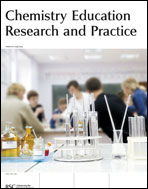Educational analysis of the first year chemistry experiment ‘Thermodynamics Think-In’: an ACELL experiment
Abstract
This paper describes an educational analysis of a First Year University chemistry practical called ‘Thermodynamics Think-In’. The analysis follows the formalism of the Advancing Chemistry by Enhancing Learning in the Laboratory (ACELL) project, which includes a statement of education objectives, and an analysis of the student learning experience. The practical consists of a suite of ten well-known, short experiments on the general theme of ‘thermodynamics in chemical change’. Pairs of students undertake a specified and graded set of five of these experiments. All experiments require careful observation by both students, followed by discussion between them until a common, mutually-agreed explanation for their observations can be formulated. The pair then discusses their explanation with a demonstrator, who may challenge it, point out flaws, or provide new information. Student surveys were conducted using the ACELL Student Learning Experience instrument. Analysis of the data shows that students enjoy working on the practical, and report it to be a beneficial learning experience that effectively develops their understanding of thermodynamic principles. The practical also fosters significant interest, and through a process of collaboration and cooperation aids the students in further developing their generic thinking skills. [Chem. Educ. Res. Pract., 2007, 8 (2), 255-273.]
- This article is part of the themed collection: The Laboratory in Science Education: The State of the Art

 Please wait while we load your content...
Please wait while we load your content...